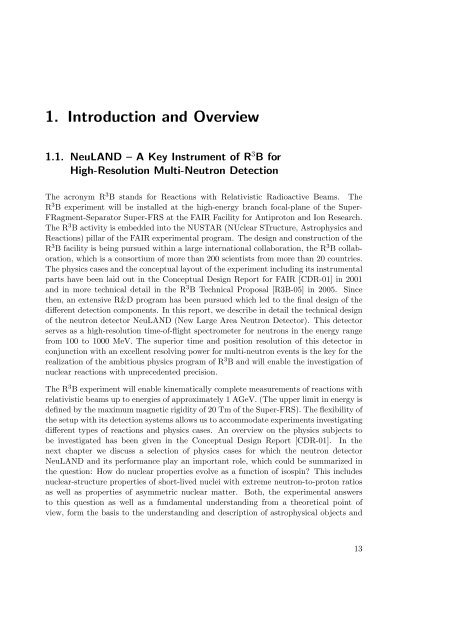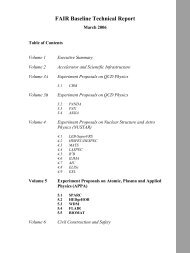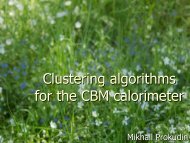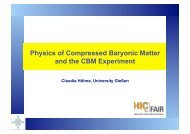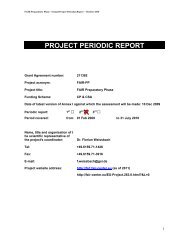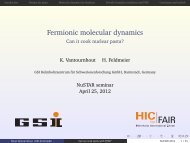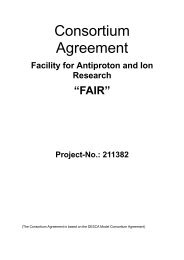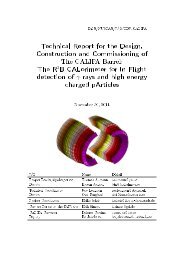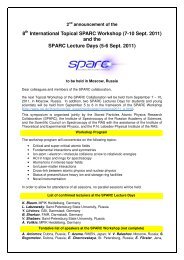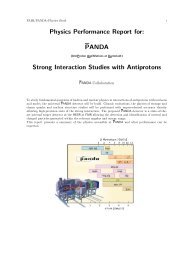NeuLAND - FAIR
NeuLAND - FAIR
NeuLAND - FAIR
You also want an ePaper? Increase the reach of your titles
YUMPU automatically turns print PDFs into web optimized ePapers that Google loves.
1. Introduction and Overview<br />
1.1. <strong>NeuLAND</strong> – A Key Instrument of R 3 B for<br />
High-Resolution Multi-Neutron Detection<br />
The acronym R 3 B stands for Reactions with Relativistic Radioactive Beams. The<br />
R 3 B experiment will be installed at the high-energy branch focal-plane of the Super-<br />
FRagment-Separator Super-FRS at the <strong>FAIR</strong> Facility for Antiproton and Ion Research.<br />
The R 3 B activity is embedded into the NUSTAR (NUclear STructure, Astrophysics and<br />
Reactions) pillar of the <strong>FAIR</strong> experimental program. The design and construction of the<br />
R 3 B facility is being pursued within a large international collaboration, the R 3 B collaboration,<br />
which is a consortium of more than 200 scientists from more than 20 countries.<br />
The physics cases and the conceptual layout of the experiment including its instrumental<br />
parts have been laid out in the Conceptual Design Report for <strong>FAIR</strong> [CDR-01] in 2001<br />
and in more technical detail in the R 3 B Technical Proposal [R3B-05] in 2005. Since<br />
then, an extensive R&D program has been pursued which led to the final design of the<br />
different detection components. In this report, we describe in detail the technical design<br />
of the neutron detector <strong>NeuLAND</strong> (New Large Area Neutron Detector). This detector<br />
serves as a high-resolution time-of-flight spectrometer for neutrons in the energy range<br />
from 100 to 1000 MeV. The superior time and position resolution of this detector in<br />
conjunction with an excellent resolving power for multi-neutron events is the key for the<br />
realization of the ambitious physics program of R 3 B and will enable the investigation of<br />
nuclear reactions with unprecedented precision.<br />
The R 3 B experiment will enable kinematically complete measurements of reactions with<br />
relativistic beams up to energies of approximately 1 AGeV. (The upper limit in energy is<br />
defined by the maximum magnetic rigidity of 20 Tm of the Super-FRS). The flexibility of<br />
the setup with its detection systems allows us to accommodate experiments investigating<br />
different types of reactions and physics cases. An overview on the physics subjects to<br />
be investigated has been given in the Conceptual Design Report [CDR-01]. In the<br />
next chapter we discuss a selection of physics cases for which the neutron detector<br />
<strong>NeuLAND</strong> and its performance play an important role, which could be summarized in<br />
the question: How do nuclear properties evolve as a function of isospin? This includes<br />
nuclear-structure properties of short-lived nuclei with extreme neutron-to-proton ratios<br />
as well as properties of asymmetric nuclear matter. Both, the experimental answers<br />
to this question as well as a fundamental understanding from a theoretical point of<br />
view, form the basis to the understanding and description of astrophysical objects and<br />
13


